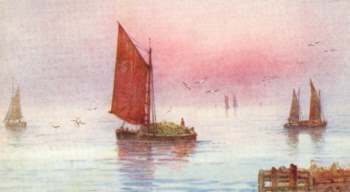Thames Sailing Barges
|
Thames barges played a vitally important part in the life of East Essex by making use of the many creeks and inlets to collect the produce from the farms and take it to the markets. Barges were very flat bottomed wooden craft to ensure that they could navigate the many shallow inlets by sailing in as little as 3 feet of water and then lie on the mud without tilting. They were sized 80 feet long by 20 feet wide to ensure that they could carry a large load. A crew of two, often family members, sailed barges which must have been physically hard work as barges sailed in all weathers. The distinctive sails have a large topsails ,mainsail and foresail on two masts. The rusty red colour is due to the waterproofing traditionally used on the sails.
One of the common uses was to carry hay as pictured above. Although the cargo was light it was bulky and it was common to see a barge loaded with 12 feet of hay on top of the decks with the helmsman at the wheel totally blind relying on information from an assistant perilously perched on top of the hay. Quays for large barges were established at Pigeon Dock, Mayland, the Quay, Bradwell on Sea, The Quay , Burnham on Crouch and Stokes Hall, Althorne but smaller barges tied up at many places on the riverbank to load hay and corn for farms to be taken to the mills and fresh flour, wildfowl and produce to go to the London markets. The fastest passage would be made in one day although the average journey time was two days. Longer journeys in adverse weather could spell financial disaster for the bargemen if they were carrying fresh produce. The barges of Burnham and Bradwell were the only barges to deliver produce to London during the plague a service for which they were accorded privilege trade status in the years to follow.
H Rider Haggard wrote of the Dengie marshes in his book Rural England published in 1902 showing how the barges penetrated far inland on small inlets.. On the distant deep some sails and in the middle marsh, a barge gliding up a hidden creek as though she moved across a solid land. Bradwell Quay was home to a fleet of 17 barges including the 55 ton Duchess and the 54 ton Veronica that were operated by Clement W Parker .Parker's blue flag containing a white hand on a red heart was one of the best known flags in the Blackwater. Clem Parker and his family lived at Peakes Farm which was on a comparatively high spot overlooking Bradwell Creek and the Quay that enabled him to keep on eye on his small fleet. For the full story of Clement Parker click here. Other barges were operated from Bradwell by the Kirby family, th Spitty's and John Parker. About 15 barges operated from Burnham , mostly by the Prior family one of which ,Reginald J Prior operated the 45 ton Mayland from Burnham under a flag with horizontal red white and red stripes.James Cardnell operated 3 barges on the Blackwater including the George and Annie.
Barges played an important role in the second world war firstly by replacing the more modern coasters that requisitioned by the Navy. For a page on the Thames barges part in the two world wars click here. Once the nations recovery began their importance waned with better road transport and more efficient motor power vessels making barges obsolete for trade purposes. By 1950 the trade in the Crouch has stopped using Burnham on Crouch and Althorne and had reduced to Beatrice Maud who service Battlesbridge mill , Salcote Belle who service Hullbridge Mill and Lord Roberts and Joy who served Stambridge Mill on the River Roach. The trade to Mayland and Bradwell had stopped with all the River Blackwater trade ending at Maldon Quay. Barges are still to be found on the Blackwater and Crouch Rivers . A number are moored at Maldon Quay both Burnham and Pagelsham often plays host to visiting barges. Barges can be seen at weekends in full sail taking visitors from Maldon as far as Osea Island.
The highlight of the year is the annual London barge race when many barges compete on a course off the coast. There are a number of other pages on this site about the River Blackwater including a page on the impact of Thames Barges in World Wars 1 and 2. To visit these pages please visit the main index by clicking the District History button above. There are several sites on the internet providing details of barges. Visitors are recommended to visit the Mersea Museum site who provide an index with details of all of the registered barges that worked the River Blackwater and Crouch. To visit this site please click here. |








